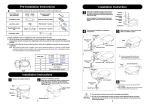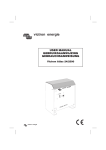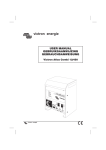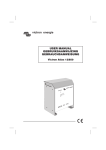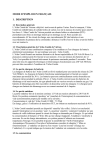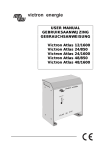Download USER MANUAL GEBRUIKSAANWIJZING
Transcript
USER MANUAL GEBRUIKSAANWIJZING Phoenix 12/300 Phoenix 12/500 Phoenix 24/500 Phoenix 24/900 SECTIONS page English Nederlands 7 37 manual 3 4 manual USER MANUAL Phoenix 12/300 Phoenix 12/500 Phoenix 24/500 Phoenix 24/900 manual 5 6 manual INTRODUCTION Victron Energy has established an international reputation as a leading designer and manufacturer of energy systems. Our R&D department is the driving force behind this reputation. It is continually seeking new ways of incorporating the latest technology in our products. Each step forward results in value adding of technical and economical features. Our proven philosophy has resulted in a full range of state-of-the-art equipment for the supply of electrical power. All our equipment meets the most stringent requirements. Victron Energy energy systems provide you with high quality AC supplies at places where there are no permanent sources of mains power. An automatic stand-alone power system can be created with a configuration comprising a Victron Energy inverter, battery charger, mains manager (if required) and, last but not least, batteries with sufficient capacity. Our equipment is suitable for countless situations in the field, on ships or other places where a mobile 230 VoltAC power supply is indispensable. Victron Energy has the ideal power source for all kinds of electrical appliances used for household, technical and industrial purposes, including instruments susceptible to interference. All of these applications require a high quality power supply in order to function properly. Victron Phoenix inverter This manual contains directions for installing the Phoenix inverter. It describes the functionality and operation of the Phoenix inverter, including its protective devices and other technical features. manual 7 CONTENTS 1. DESCRIPTION ..............................................10 1.1 1.2 2. General .......................................................................10 Victron Phoenix inverter ..............................................10 SAFETY .........................................................12 2.1 2.2 2.3 2.4 2.4.1 2.4.2 2.4.3 2.5 2.5.1 2.5.2 2.6 2.7 3. INSTALLATION AND CONNECTION............15 3.1 3.2 3.2.1 3.2.2 3.3 3.4 3.5 3.6 3.7 4. Location.......................................................................15 Installation requirements.............................................15 Installation equipment 15 Battery cables 15 Connections ................................................................16 Connecting the battery cables.....................................17 Connecting the 230 Vac cables....................................18 Remote control connection .........................................19 Various points of attention ..........................................19 OPERATION..................................................20 4.1 4.2 4.3 4.4 4.5 4.6 4.6.1 4.6.2 4.7 4.8 8 Short circuit protection ................................................12 Short term power / surge power limitation ..................12 Temperature protection...............................................12 Low input voltage protection .......................................13 13 12 VoltDC battery 13 24 VoltDC battery Alarm indication ‘low batt.’ 13 High input voltage protection.......................................13 13 12 VoltDC battery 13 24 VoltDC battery Reversed polarity ........................................................13 Ripple voltage protection.............................................14 LED indications ...........................................................20 On/off/economy switch................................................20 Overload indication .....................................................20 Low battery indication .................................................21 Temperature indication ...............................................21 Adjustments ................................................................21 Adjusting output level 21 Unloaded output voltage 21 Economy mode ...........................................................22 Maintenance................................................................22 manual 5. BATTERY CAPACITY....................................23 6. FAULT TRACING LIST ..................................25 6.1 6.2 6.3 7. 7.1 7.2 7.3 7.4 7.5 8. 8.1 8.2 General .......................................................................25 Trouble shooting .........................................................25 The ac output voltage is too low..................................27 SPECIFICATIONS .........................................28 Input ............................................................................28 Output .........................................................................29 Economy mode ...........................................................30 General .......................................................................30 Mechanical ..................................................................31 DRAWINGS ...................................................32 Dimensions .................................................................33 Connection diagram ....................................................34 manual 9 1. DESCRIPTION 1.1 GENERAL All Victron Phoenix inverters are tested to ensure correct functioning before leaving the factory. They are packed first in shock-absorbing polystyrene and then in sturdy cardboard boxes for secure transportation. The Victron Phoenix is housed in a robust aluminum cabinet (IP21) suitable for floor or wall mounting. The AC output terminals, the DC battery terminals and the terminals for a remote control switch (if used) can be reached by opening the front of the cabinet with a screwdriver. 1.2 VICTRON PHOENIX INVERTER The coding of the Phoenix inverter model is composed as follows: For example Phoenix 12/500: ‘12’ = 12 VDC = battery voltage ‘500’ = 500 W = continuous electrical load The Victron Phoenix inverter is designed for 12 or 24 VDC battery input voltages and produces a sinusoïdal output voltage of 230 VAC, 50 Hz (crystal controlled). Continuous power can be delivered at all times (see the specifications). The inverter is developed to serve AC equipment requiring a high quality energy input. That is, when correct functioning is dependent on true sinewave supplies such as: computers, satellite communications equipment, and precision measuring instruments, particularly in mobile applications. The Phoenix inverter uses high frequency switching techniques in combination with a low frequency transformer resulting in a very high 10 manual efficiency for the user. For power consumption in a no-load situation, see section 7.1. Watt = unit of power Volt = unit of voltage VoltRMS = root mean square (effective value of alternating wave) Hertz = unit of frequency The power supply of the Phoenix inverter is: Phoenix 12/300 Phoenix 12/500 Phoenix 24/500 Phoenix 24/900 1. 2. 3. continuous(1) power short term (2) power surge power(3) 300 W 500 W 500 W 900 W 400 W 650 W 750 W 1000 W 1300 W 1350 W 1400 W 2500 W Continuous power: the continuous power at 40°C ambient temperature. Short term power: the power during 30 minutes at 40°C ambient temperature. Surge power: the power during 3 seconds at 40°C ambient temperature. manual 11 2. SAFETY To protect your equipment and connected loads against internal electronic damage the following built-in safety measures are integrated in the Phoenix inverter. 2.1 SHORT CIRCUIT PROTECTION short circuit current = current supplied when a short-circuit on the output occurs. The inverter's output is protected against short-circuits. The short-circuit current for the 12V version is 5.5 ARMS (approximately). The 24V version have a short circuit current of 11ARMS (approximately). In this condition the output voltage approaches 0 V. The LED ‘overload’ will flash for three seconds, after three seconds the LED ‘overload’ will illuminate continuously and the inverter switches off. At most 30 seconds after the short-circuit has been removed the inverter resumes normal operation. 2.2 SHORT TERM POWER / SURGE POWER LIMITATION The Phoenix inverter can deliver a higher short-term power and a surge power for 3 seconds (see section 1.2). This level is electronically limited. When the inverter is overloaded the LED ‘overload’ will flash. If the overload is too high the inverter will switch off and the LED ‘overload’ will illuminate continuously. 2.3 TEMPERATURE PROTECTION The temperature of the electronics is continuously monitored. The inverter switches off before the temperature reaches an unacceptable high level due to output short-circuit, overload or excessive ambient temperatures. The LED ‘temp’ will flash to indicate that critical temperature is almost reached. If the internal temperature is too high the LED ‘temp’ will illuminate and the inverter switches off. The inverter restarts automatically once the temperature has dropped to an acceptable level. 12 manual 2.4 LOW INPUT VOLTAGE PROTECTION 2.4.1 12 VoltDC battery The inverter switches off if the input voltage drops below 9.6 VDC and restarts once the input voltage has risen above approximately 11.0 VDC. 2.4.2 24 VoltDC battery The inverter switches off if the input voltage drops below 19.5 VDC and restarts once the input voltage has risen above approximately 22.0 VDC. 2.4.3 Alarm indication ‘low batt.’ If the battery voltage is low the LED ‘low batt.’ will flash. When the battery voltage is too low the inverter will switch off and the LED ‘low batt.’ will illuminate continuously. 2.5 HIGH INPUT VOLTAGE PROTECTION 2.5.1 12 VoltDC battery The inverter switches off if the input voltage rises above 17.0 VDC and restarts once the input voltage has dropped below approximately 16.5 VDC. 2.5.2 24 VoltDC battery The inverter switches off if the input voltage rises above 32.5 VDC and restarts once the input voltage has dropped below approximately 31.0 VDC. 2.6 REVERSED POLARITY The Victron Energy Phoenix 12/300, 12/500, 24/500 and 24/900 are electronically protected against reverse polarity. Reversing the polarity at the input of these inverters does not damage the inverter in any way. After connecting the battery cables switch the inverter ON. If the inverter does not work, switch it OFF and change the polarity of the battery cables. manual 13 2.7 RIPPLE VOLTAGE PROTECTION The Victron Energy Phoenix 12/300, 12/500, 24/500 and 24/900 are protected against too high ripple voltage at the input. If the rms value of the input voltage-ripple exceeds 10% of the nominal DC input voltage, the inverter will state an alarm; the LED ‘low batt.’ and the LED ‘overload’ will flash. If the previous alarm situation is on for a period of over 21 minutes, the inverter will switch off and the following alarm indication can be seen; the LED ‘low batt.’ and the LED ‘overload’ illuminate. The inverter has to be resetted before it will continue operation. Resetting can be done by means of switching the inverter off and on again. 14 manual 3. INSTALLATION AND CONNECTION 3.1 LOCATION Install the inverter in a dry area with good ventilation. NOTE: High ambient temperatures will impair efficiency and shorten working life or will completely shut the inverter off (see section 7 ‘Specifications’). There are holes in the bottom and rear of the cabinet enabling floor or wall mounting. For dimensions see section 8 (‘Dimensions’). Except for the Phoenix 12/300 and the Phoenix 24/500, the inverter has a built in fan. The Phoenix without fan has to be mounted in a vertical position due to natural convection. The Phoenix with fan can be mounted in any position, although it is recommended to mount the unit in a vertical position for optimal cooling. Make sure you will have easy access to the inside of the unit after installation. Keep the distance between the Phoenix inverter and the battery as short as possible to minimize the losses in the cables. 3.2 INSTALLATION REQUIREMENTS The Victron Phoenix inverter should be installed with the help of the following equipment: 3.2.1 Installation equipment • two battery cables (max. length 6 meters, with clamps) • one spanner or wrench (10 mm or M6), to connect the battery cables. • one screw driver (no. 1), to connect the 230 VAC cables 3.2.2 Battery cables The cross sections of the battery cables are suitable for continuous loads and peak loads. Phoenix 12/300 Phoenix 12/500 Phoenix 24/500 Phoenix 24/900 length 0 - 1.5 meters length 1.5 - 6 meters 6 mm2 10 mm2 6 mm2 6 mm2 10 mm2 16 mm2 10 mm2 10 mm2 Avoid contact resistances by tightening all connections. manual 15 3.3 CONNECTIONS The connections are an important issue. The connections are situated inside the unit on the PCB (Illustration 1). The battery connections are coded and indicate the positive (‘+’) and the negative (‘-‘) connections. Illustration 1. 16 manual Earth connection The ground connection (earth protection conductor) from the mains is located on the AC-terminal block (Illustration 1). The circuit is functional only if the cabinet is connected to earth. A M4 earth screw is fitted in the bottom of the cabinet. Connect the cabinet earth terminal to earth (Illustration 2). The earth for vessels is the hull or earth plate; for motor vehicles it is the chassis. Illustration 2. 3.4 CONNECTING THE BATTERY CABLES To take full advantage of the Phoenix inverter, particularly under peak/surge load conditions, the inverter should be connected to the battery with special battery cables. See section 3.2.2. Connection procedure battery cables The following procedure is to be carried out carefully. step 1. Unscrew the four screws of the front panel. step 2. Connect the battery cables: the '+' (red) to the left and the '-' (black) to the right. step 3. If the DC-input cables to the inverter are connected in reverse polarity (+ on - and – on +), the inverter will not work. step 4. If the inverter does not work disconnect the cables and re-connect them correctly. manual 17 step 5. Make sure that the connections are screwed tight; (use a 10 mm or M6 spanner or wrench). 3.5 CONNECTING THE 230 VAC CABLES The terminal block is located on the PCB (see Illustration 1). The 230 VAC external equipment must be connected to the inverter by means of a three-wire cable. Use a cable with a flexible core and a cross section of 2.5 mm². Connection procedure 230 VAC cables step 1. Unscrew the four screws of the front panel . step 2. The 230 VAC equipment may be directly connected to the connector block on the left side of the PCB, with a three-wire cable. The connections are clearly coded and from left to right they are: ‘L’, ‘N’, and ‘PE’. The AC output is automatically current limited in the event of a short circuit on the output (see section 2.1). The inverter will be seriously damaged if an external voltage is connected to the inverter's AC-block. This damage will occur regardless of the switch position of the inverter is ‘ON’ or ‘OFF’. step 3. Replace the front panel with the four screws. 18 manual 3.6 REMOTE CONTROL CONNECTION Phoenix inverters can be switched ‘on’, ‘off’ and ‘economy’ by remote control. In addition all five indicator LED's can also be remotely connected. Illustration 3 illustrates how to make the connections. Alternatively a complete remote control panel, incorporating the indicator LED’s and ‘on/off/economy’ switch is available from Victron Energy. Illustration 3. 3.7 VARIOUS POINTS OF ATTENTION The rms value of the ripple voltage at the input should be limited to maximum 10% of the DC input voltage. Never use a battery charger as a power supply for these Victron Energy inverters, unless batteries or a suitable ripple suppressor are connected. manual 19 4. OPERATION 4.1 LED INDICATIONS The switch and LED’s are located on the front of the Phoenix inverter (see Illustration 4). LED’s: On = indication when unit is 'ON'. Economy = indication when unit is in ‘economy’ mode. Overload = indication for overload condition. low batt. = indication for low battery condition. Temp. = indication for high temperature condition. Illustration 4. 4.2 ON/OFF/ECONOMY SWITCH With the ‘on/off/economy’ switch the inverter switches on, off or in economy mode, (see Illustration 5). When switching to ‘ON’, the following startup procedure takes place 1. The LED ‘low batt’ will illuminate for one second; 2. The LED ‘on’ will illuminate. Illustration 5. 4.3 When switching to ‘economy’ the led ‘economy’ will flash. If the load is high enough the inverter will switch on and the led ‘economy’ and the led ‘on’ will illuminate. (see section 4.7). OVERLOAD INDICATION When the inverter is overloaded, the 'overload' LED will flash. If the overload is too high the inverter will switch off automatically, in this case the LED ‘overload’ will illuminate continuously. The Phoenix inverter will automatically switch on again after 25 seconds. 20 manual 4.4 LOW BATTERY INDICATION The LED 'low batt.' will illuminate and the inverter will switch off, if the input voltage to the inverter is too low due to: • A discharged battery; • A relatively low battery capacity with respect to the high loads by which the input voltage is significantly reduced; • Battery cables are too thin and / or too long. • Insufficient battery capacity for the high output power of the inverter; • Poor battery condition. The inverter will switch ‘ON’ as the input voltage is increased to within specifications. 4.5 TEMPERATURE INDICATION The LED 'temp.' will illuminate in the event of high ambient temperatures and when heavily overloaded. The Phoenix inverter will then switch off . As the temperature has dropped to a sufficiently low level, the inverter will automatically switch on again. 4.6 ADJUSTMENTS To adjust output voltage, open the Phoenix inverter cabinet, by loosening the four screws on the front, and removing the front panel (see Illustration 6). It will be necessary to remove the dripshield and top plate to gain access to the adjustment potentiometers. Illustration 6. 4.6.1 Adjusting output level The output voltage is factory set to approximately 230 VAC. In the event one wishes to change that value it can be adjusted with potentiometer R15 (see Illustration 1 section 3.3), that permits an adjustment of approximately + 5% and – 20%. Refit the top plate, dripshield and front. 4.6.2 Unloaded output voltage The unloaded output voltage of the Phoenix inverter is approximately 230 VAC. manual 21 4.7 ECONOMY MODE When the inverter is switched in ‘economy’ mode (bottom position of the switch), the yellow LED ‘economy’ flashes to indicate that the economy mode has been activated. The inverter starts as soon as the load at the output exceeds 26 Watt. The green LED ‘on’ lights up and the yellow LED ‘economy’ will also light up continuously . The inverter switches back to the ‘economy’ mode as soon as the load drops below 13 Watt. The yellow LED ‘economy’ flashes again and the green LED ‘on’ is off. 4.8 MAINTENANCE Phoenix inverters do not require any specific maintenance other than a yearly inspection of the connections. Keep the unit dry and as clean as possible. 22 manual 5. BATTERY CAPACITY If the power ratings are known of the equipment to be powered by the Phoenix inverter and the duration that the inverter is expected to power the equipment for, the minimum battery capacity can be calculated. Make a list of all equipment to be powered by the Phoenix inverter and sum up each single power consumption multiplied by the duration of time in hours, during which power will be consumed (Watt-hours). Add the internal loss of the Phoenix inverter. The calculation on the internal loss is a two step process. First we calculate the loss when the inverter is supplying power to a load. The efficiency of the inverter in this state is 85%, adding roughly 15% to the power consumption. When the inverter is not supplying power to a load, power consumption is approximately 8.5W in ‘on’ mode or 2.5W in ‘economy’ mode. Determine the number of Ah by dividing the power consumption by the nominal battery voltage (for example 24 VDC). The result is the electrical consumption in Ah's. The result is the total battery capacity-consumption in Ah's. Multiply this value with a safety factor of 1,7 and the result is the recommended minimum battery capacity. manual 23 Example with a Victron Energy Phoenix 24/500 inverter: Equipment Colour TV VHS-recorder Hi-fi equipment Lights Computer Power 100 W 50 W 50 W 100 W 100 W Number of hours on 4 4 4 4 3 Consumption 400 Wh 200 Wh 200 Wh 400 Wh 300 Wh Consumption: 1500 Wh Internal loss of the inverter supplying the load (15% of 1500Wh) 225 Wh Internal loss of the inverter not supplying a load for 12 hours (12 hours x 8,5 W) 102 Wh Total power consumption 1827 Wh Total battery capacity-consumption in Ah (1827/24 Volt): 76 Ah Daily use safety factor Required in Ah 76 Ah x 1,7 = 129Ah The result is, with a requirement of 129 Ah; the battery should have a minimum capacity of 130 Ah. This example is suitable for a standard leadacid battery. For 'sealed' and 'gel' batteries the recommended safety factor can be as low as 1.3, permitting a smaller battery capacity. Please consult your battery manufacturer's specifications. 24 manual 6. FAULT TRACING LIST 6.1 GENERAL This list will facilitate the rapid tracing of the most common types of faults. Before performing checks on the inverter you must disconnect all other 12VDC or 24 VDC equipment from the batteries. 6.2 TROUBLE SHOOTING If the fault cannot be solved, consult your Victron Energy dealer. Problem Possible cause Solution The inverter does not work when switched on: The input voltage is too high or too low. Make sure that the input voltage is within the correct values, see section 7 for these values. Switch the inverter off and connect the battery correctly. The LED ‘low batt.’ flashes: The LED ‘low batt.’ illuminates: The LED ‘overload’ flashes: The LED ‘overload’ illuminates: manual The plus ‘+’ and the minus ‘-‘ of the batteries and the inverter do not correspond. The battery voltage is low. The inverter is switched off because the battery voltage was too low. The load connected to the inverter is higher than the nominal load. The inverter is switched off due to a too high load. Recharge the batteries or check the battery connections. Recharge the batteries or check the battery connections. Disconnect a part of the load. Disconnect a part of the load. 25 Problem The LED ‘temp.’ flashes: The LED ‘temp.’ illuminates: The LED’s ‘low batt.’ and ‘overload’ are flashing: Possible cause Solution The ambient temperature is high, or the temperature of internal components is high or the load is too high. The inverter is switched of due to a too high ambient or component temperature or the load is too high. Low battery voltage and too high load or the ripple voltage at the input exceeds 10%. Place the inverter in a cool well-ventilated place, or disconnect a part of the load. The LED’s ‘low batt.’ and ‘overload’ illuminate: The inverter is switched off due to a too high ripple voltage at the input. One alarm LED is illuminating and the second one is flashing: The inverter is switched off due to the alarm indicated by the illuminating LED. The flashing LED indicates that the inverter nearly switched off at that alarm. 26 Place the inverter in a cool well-ventilated place, or disconnect a part of the load. Recharge the batteries, disconnect a part of the load, or place a ripple suppressor and/or batteries with a higher capacity. Mount shorter and/or thicker battery cables. Place a ripple suppressor and/or batteries with a higher capacity. Mount shorter and/or thicker battery cables and reset the inverter (switch OFF and ON again). Check this table to take actions that correspond to the alarm. manual 6.3 THE AC OUTPUT VOLTAGE IS TOO LOW The AC output voltage is too low when measured by means of a RMS voltmeter. Turn potentiometer R15 (see section 4.6, ‘Adjustments’), to the right and check whether the voltage returns to the normal value. If not, contact your Victron Energy dealer to have the inverter repaired. manual 27 7. SPECIFICATIONS 7.1 INPUT Nominal input voltage: Phoenix 12/300 Phoenix 12/500 Phoenix 24/500 Phoenix 24/900 : : : : 12 VoltDC 12 VoltDC 24 VoltDC 24 VoltDC Input voltage range: Phoenix 12/300 Phoenix 12/500 Phoenix 24/500 Phoenix 24/900 : : : : 9,6 – 17,0 VoltDC 9,6 – 17,0 VoltDC 19,5 – 32,5 VoltDC 19,5 – 32,5 VoltDC Switch-on voltage (low): Phoenix 12/300 Phoenix 12/500 Phoenix 24/500 Phoenix 24/900 : : : : 11,0 VoltDC 11,0 VoltDC 22,0 VoltDC 22,0 VoltDC Switch-on voltage (high): Phoenix 12/300 Phoenix 12/500 Phoenix 24/500 Phoenix 24/900 : : : : 16,5 VoltDC 16,5 VoltDC 31,0 VoltDC 31,0 VoltDC Switch-off voltage (low): Phoenix 12/300 Phoenix 12/500 Phoenix 24/500 Phoenix 24/900 : : : : 9,6 VoltDC 9,6 VoltDC 19,5 VoltDC 19,5 VoltDC Switch-off voltage (high): Phoenix 12/300 Phoenix 12/500 Phoenix 24/500 Phoenix 24/900 : : : : 17,0 VoltDC 17,0 VoltDC 32,5 VoltDC 32,5 VoltDC 28 manual Voltage ripple Nominal input current: Phoenix 12/300 Phoenix 12/500 Phoenix 24/500 Phoenix 24/900 Maximum input current: Phoenix 12/300 Phoenix 12/500 Phoenix 24/500 Phoenix 24/900 Power consumption: No-load in ‘ON’ mode: The 12V version The 24V version No-load in ‘economy’ mode: All four types 7.2 : max. 10 % VRMS of nominal DC input voltage. : : : : 30 A at 12V/300W 52 A at 12V/500W 25 A at 24V/500W 44 A at 24V/900W : : : : 185 A 185 A 90 A 170 A : : 8,5 W 10,6 W : 2,5 W : : : : : : 230 VAC +/- 1% 185 VAC – 245 VAC 50 Hz +/- 0.2% (crystal controlled) sine wave max. 2,5% 0,2 capacitive to 0,4 inductive : : : : 300 W 500 W 500 W 900 W (cos phi = 1,0) 0ºC / +40ºC At higher ambient temperatures the power is re-adjusted automatically. OUTPUT Output voltage Output voltage range Frequency Waveform output voltage Total harmonic distortion Powerfactor (cos phi) Nominal power: Phoenix 12/300 Phoenix 12/500 Phoenix 24/500 Phoenix 24/900 Temporary max. power at 40ºC ambient temperature: Phoenix 12/300 Phoenix 12/500 Phoenix 24/500 Phoenix 24/900 manual : : : : Short term 400 W 650 W 750 W 1000 W Surge 1300 W 1350 W 140 W 2500 W 29 Switch-on behavior : Efficiency Type 12/300 : 12/500 24/500 24/900 Pnom 1 /2 Pnom 81% 85 % 80 % 85 % 84% 85 % 82 % 84 % Dynamic stability : Recovery time Overload protection : : Short circuit protection : 7.3 : : : 26 W 13 W 60 msec. 230VRMS 50Hz, 1 second no voltage. : : Natural convection Forced convection (internal) : The temperature of critical components is measured with sensors (PTC's). The sensors switch the inverter off when maximum component temperature specifications are reached. When temperature returns within limits the inverter switches on automatically. GENERAL Cooling 12/300 and 24/500 Cooling 12/500 and 24/900 Protection against excessive ambient temperatures, overload and short circuit 30 maximum 10 % short duration surges when switching on and off at 50 % nominal load. 3 periods The inverter is protected against overload. The output is short circuit proof. The circuit current is approx. 5,5 ARMS for the 12V version and 11 ARMS for the 24V version. ECONOMY MODE Switch-on load Switch-off load Testvoltage economy 7.4 The inverter can be switched on under any load conditions. manual Relative humidity Environment conditions Operating temperature Storage temperature : 0-95% : : 0 - 50°C -25 - +70°C : : : EN 55014 (1993) EN 55104 (1995) EN 60950 (1991) Case Colour Dimensions (hxwxd) Weight Output 230 VAC : : : : : Input 12 or 24 VDC Remote on/off : : Aluminum IP 21 Blue (RAL 5012) epoxy 283 x 200 x 180 mm 8,5 kg Connections on PCB ∗) (Connector suitable for 2,5 mm2 wires). Connections on PCB (M6 bolts) Connections on PCB ( Connector suitable for 1,5 mm2 wires). EMC: Electro-magnetic compatibility according Council Directive 89/336 EEC Emission Immunity Safety 7.5 ∗) MECHANICAL PCB= Printed Circuit Board manual 31 8. DRAWINGS Victron Energy Phoenix inverter dimensions Victron Energy Phoenix inverter connections 32 manual 33 34 8.1 DIMENSIONS manual 33 8.2 34 CONNECTION DIAGRAM manual



































